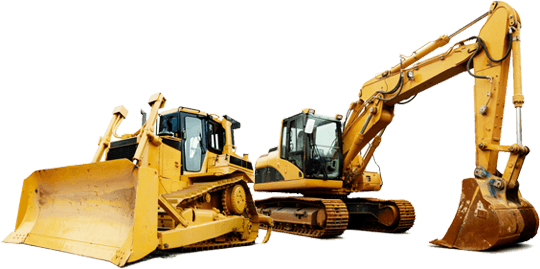Moving Overseas
Moving Overseas with Ease
Self-Pack Shipping Containers for Hassle-Free International Shipping!

Relocating Overseas Self-Pack International
Shipping Containers
 Streamlined Shipping, Global Reach
Streamlined Shipping, Global Reach
CargoMaster Saves You Time and Money!
Adelaide, Brisbane, Darwin, Hobart, Melbourne, Perth, Sydney,
Darwin, Canberra, Cairns, Townsville, Mackay
CargoMaster ensures the safe delivery of your goods worldwide, catering to both personal and business shipments with various shipping options. CargoMaster’s self-pack containers provide a reliable and efficient solution for moving freight quickly and securely, whether for relocating homes or sending shipments overseas.
With CargoMaster’s extensive experience and established network, you can trust us to handle your international shipping needs seamlessly. From documentation to logistics, CargoMaster takes care of everything, ensuring a stress-free moving experience.
Why Choose CargoMaster?
- Expertise: Benefit from genuine self-pack shipping professionals with real experience, knowledge, and know-how.
- Comprehensive Services: CargoMaster handles all aspects of international sea freight shipping, including documentation, bank guarantees, and more.
- Security Clearance: Rest assured knowing that all CargoMaster staff are police security cleared.
- Specialized Services: From large project sea freight to valuable heavy sea cargo, CargoMaster has established relationships with insurance companies and attorneys specializing in maritime law.
- Global Network: Weekly self-pack container services are available to most worldwide cities, backed by an established and proven international sea freight network.
- Convenient Locations: CargoMaster operates from and to major Australian cities, with moving containers available even in remote locations.
- Proven Track Record: With over 35 years of experience, CargoMaster has successfully moved thousands of clients worldwide.
- Easy Process: Book your self-pack container, pack at your convenience, and let CargoMaster handle the rest, including pickup, export documentation, and shipping to the destination.
- Cost-Effective Solutions: CargoMaster offers cost-effective self-pack shipping options for individuals and families moving from Australia to international destinations.
Moving Overseas Made Easy
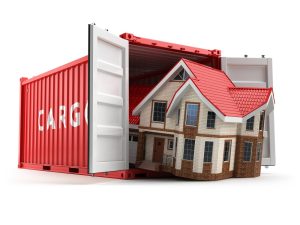 CargoMaster provides comprehensive international moving services from Australia to most locations worldwide. Whether you’re shipping a few boxes or an entire household, CargoMaster can help with LCL (Less than Container Load) or FCL (Full Container Load) shipments.
CargoMaster provides comprehensive international moving services from Australia to most locations worldwide. Whether you’re shipping a few boxes or an entire household, CargoMaster can help with LCL (Less than Container Load) or FCL (Full Container Load) shipments.
- LCL Shipments: Cost-effective way to move belongings overseas, with CargoMaster handling collection, palletization, and consolidation.
- FCL Shipments: Ideal for shipping the entire contents of your home, with CargoMaster delivering empty containers for packing and handling export documentation and shipping to the destination.
- Packing Services: CargoMaster offers professional packing services for easy and stress-free moving.
- Shipping Vehicles: CargoMaster can also help with shipping vehicles, offering blocking and bracing services for safe transportation.
Air Freight Services:
For time-sensitive cargo, CargoMaster offers international air freight services with varying transit times depending on the destination. CargoMaster also provides cargo insurance options for both air and sea freight consignments.
Advantages of Self Pack International Shipping Container
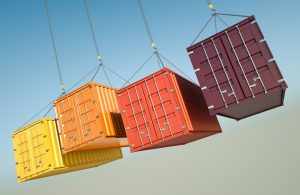 Minimal Handling: Reduce the risk of damage or loss by minimizing the handling of your goods.
Minimal Handling: Reduce the risk of damage or loss by minimizing the handling of your goods.- Real-Time Tracking: Access electronic tracking of your container as soon as it’s loaded onto the vessel.
- Enhanced Security: Seal your packed container with a numbered bolt seal, ensuring it remains sealed until delivery.
- Flexible Timing: Choose when your container departs and plan for its arrival with advance knowledge of transit times.
- Faster Transit: Enjoy quicker transit times compared to regular international movers.
- Competitive Insurance: CargoMaster can arrange competitive insurance cover for your shipment.
- Cost-Effectiveness: Save up to 40% compared to regular international moving companies.
- Experience and Expertise: Partner with an experienced freight forwarding company for a stress-free shipping experience.
Pack Your Own Shipping Container or let CargoMaster provide a professional and experienced international container packing team for you. We can even store your self-move international container until you are ready and settled at your overseas destination.
If your premises are unsuitable for positioning a self-pack shipping container, no problem! CargoMaster offers self-pack international move and packing warehouses in Sydney, Melbourne, Brisbane, Perth, Adelaide, and Canberra.
CargoMaster’s extensive, technologically advanced international network ensures your moving container is transported safely, securely, and quickly to its ultimate destination. With our global network of Customs houses, offices, and agencies, we deliver cost-effective, secure self-pack moving containers to almost any destination on the planet.
If you are moving overseas or looking for a moving container and want to save big money, contact us today for more information about self-pack containers!
International Shipping Container Dimensions
| Type of Container | Inside Dimensions (m) | Door Opening (m) | Tare Weight (kgs) | Volume (cbm) | Loading Capacity (kgs) |
| 20′ Standard Container | 5.92×2.34×2.38 | 2.29×2.28 | 1.9 | 33 | 22.1 |
| 20′ Open Top Container | 5.92×2.34×2.38 | 2.29×2.28 | 2.177 | 31.6 | 21.823 |
| 20′ Reefer Container | 5.38×2.24×2.29 | 2.24×2.12 | 3.209 | 24.1 | 17.111 |
| 20′ Flatrack | 5.94×2.40×2.27 | 2.56 | 21.44 | ||
| 40′ Standard Container | 12.06×2.35×2.38 | 2.29×2.28 | 3.107 | 67.3 | 27.373 |
| 40′ Open Top Container | 12.064×2.34×2.37 | 2.29×2.25 | 4.445 | 64 | 26.067 |
| 40′ Reefer Container | 11.21×2.25×2.18 | 2.22×2.12 | 4.84 | 49.3 | 25.64 |
| 40′ Flatrack | 12.07×2.42×2.10 | 5.55 | 25.22 | ||
| 40′ High-Cube | 12.06×2.34×2.68 | 2.29×2.25 | 3.265 | 75.8 | 27.215 |
 How It Works:
How It Works:
- Book your self-pack container and specify your preferred delivery time.
- CargoMaster delivers the empty container to your premises or yard for packing.
- Pack your container at your own pace, attaching the provided bolt seal for security.
- Contact CargoMaster for container pickup, documentation handling, and shipping arrangements.
- Track your container’s journey in real-time for updates on departure, arrival, and transit progress.
CargoMaster offers self-pack international moving containers from major cities in Australia to remote locations, providing a flexible, secure, and cost-effective alternative to traditional international removalists.
Shipping Containers to West Africa:
Take advantage of great deals to various West African countries, including Liberia, Nigeria, Mali, Togo, Ghana, and more. CargoMaster ensures reliable and affordable shipping solutions to destinations all over Africa.
For hassle-free international shipping and cost-effective solutions, contact CargoMaster today!
Moving Overseas and Packing Tips
Prior to Your Move
- Contact CargoMaster if you need to update or change address details or item lists.
- Provide your contact numbers for both pickup and delivery. Keep your mobile phone on at all times during container delivery and collection.
- Notify us in advance of any access issues such as stairs, clearways, long walks, or hard-to-reach areas.
- Consider taking out removals insurance for added peace of mind.
- Plan your move well in advance. Self-pack moving is a significant task.
Preparing for Your International Move and Shipping
- Start packing early, as some packing may take longer than expected.
- Tie up all cords of your electrical appliances and place them in easily identifiable cartons.
- Avoid packing cartons too heavy; lighter, easy-to-handle cartons will make loading the container easier.
- Consult CargoMaster before loading motor vehicles.
- Number your cartons and use a manifest to record the contents of each carton/box as it gets loaded into the container.
- Use removalist cartons, as the cardboard is more durable. Grocery boxes may be too thin to protect contents from damage. If using garbage bags, double-bag for extra strength.
- Empty all furniture and pack the contents into cartons. Lock all furniture doors to prevent them from swinging open during shipping.
- Pack crockery and glassware carefully, using butcher’s paper to protect the bottoms and sides of the boxes. Bubble wrap is ideal for added protection.
- Consider our full packing service for a hassle-free experience at reasonable prices.
- Empty, defrost, and dry refrigerators the day before your relocation.
- Dismantle items like swings, trampolines, garden sheds, bed heads, and bed ends to fit through doorways. Empty fuel from mowers, whipper snippers, and other motorized machinery. We do not transport gas bottles due to safety hazards.
- Clean BBQ surfaces of grease and remove oil and clippings from lawn mowers.
- Pack artwork, mirrors, and pictures in picture cartons with plenty of cushioning material or bubble wrap.
- Place pictures and prints in envelopes formed by flattened cartons. Glass is the most breakable item during a move.
- Remove knobs from chests and drawers and reattach them on the inside.
- Tape garden tools, brooms, and other loose items into bundles with packing tape.
- Disconnect washing machines from taps and follow the manufacturer’s instructions to secure the bowl during transit.
- When dismantling beds and tables, collect all screws and nuts, place them in a plastic bag, and tape them securely to the item.
- Pack microwave plates with bubble wrap or plenty of crushed paper.
- Avoid loose items by packing everything into cartons.
- Pack laptops, desktop computers, and other electronic equipment into cartons, protecting them with crushed paper. It’s best to use their original packaging if available.
Freight Forwarding Services Australia
Get Started/Making a Booking
Ready to ship your cargo to? Contact us today to discuss your freight requirements and receive a competitive quote. Trust CargoMaster for reliable air and sea freight services that deliver results.
CargoMaster air freight and sea freight services from Sydney, Melbourne, Brisbane, Perth, Adelaide and Darwin to the following Pacific Islands: Papua New Guinea, Fiji, Manus Island, Nauru, East Timor, Tahiti, Tonga, Tuvalu, Hawaii, Vanuatu, Solomon Islands, Samoa, Micronesia, New Caledonia, Marshall Islands, Cook Islands, Kiribati, Guam
Air & Sea Freight Shipping Worldwide
Africa, North America, South America, The Middle East, Europe, Asia, New Zealand, Papua New Guines, Asia, United Kingdom, Europe, USA, Pacific Islands, UK, Ireland
Shipping Heavy Machinery
Quick Links: Australian Border Force, Dept of Home Affairs, Austrade, Australian Government, Australian Border Force, Dept of Home Affairs, Austrade, Australian Government, Australian Taxation Office
Overseas Customs Contacts: Algeria, Angola, Argentina, Bahrain , Bangladesh, Benin, Bolivia, Botswana, Brazil, Canada, Chile, Columbia, Congo, Croatia, Czech Republic, Denmark, Egypt, Ethiopia, Fiji, Finland, France, Germany, Ghana, Greece, Hong Kong, Hungary, Iceland, India, Indonesia, Ireland, Israel, Italy, Jamaica
Hotshots: Adelaide, Brisbane, Darwin, Hobart, Melbourne, Perth, Sydney
Addition Information
(Click the + plus symbol to expand, – minus symbol to collapse)
INTERNATIONAL AIRPORTS
|
|
INTERNATIONAL FREIGHT TRACKING
FREIGHT TERMS AND ABBREVIATIONS
| A2A | Airport-to-airport |
| A2D | Airport-to-door |
| ADV | Advise, Advised, Advising |
AEA |
Association of European Airlines (see the page “Interest Organisations” of this website also) |
Airline |
Company operating aircraft between steady origin and destination airports |
| Airmail | Mail travelling by air |
| Air Operator | Company operating aircraft |
Airport-to-airport |
Transport from an airport of origin to an airport of destination |
Allotment |
Assigned volume on board of a flight / day |
AOG |
Aircraft On Ground; materials expedited for repair of a grounded aircraft |
| AP | Airport |
| ARR | Arrive, Arrived, Arrival |
| ARR | Also, a C2K milestone: ARR = cargo and documents arrived at airport of destination |
| ATA | Air Transport Association (see the page “Interest Organisations” of this website also) |
| ATA | Actual Time of Arrival |
| ATD | Actual Time of Departure |
| Authorisation | The commission to a certain person or body to act on behalf of another person or body; the person or body can be authorised e.g., to issue air waybills or to collect freight |
| AVI | Live Animal(s) |
| AWB | Air Waybill |
| Backlog | Amount of goods still to be delivered or received and for which the planned or agreed date has expired |
| BAG | Baggage |
| Belly | Lower-deck cargo hold of an aircraft |
| BIG | Outsized cargo |
| Blocked-space agreement | A continuous reservation (allotment) for space at one or more flight / date combinations with an airline |
| Bonded Goods | Goods on which the customs duty has not yet been paid, and which therefore, are under the control of customs; usually in a Bonded warehouse. |
| Bonded warehouse | A depository for goods on which the customs duty has not been paid; the warehouse proprietor must provide a bond (often in the form of a bank warranty or a mortgage) to the customs authorities as a security for any duties which may not be paid by the customer |
| Booking | Request for reservation of space on a flight/day, (to be) confirmed by the airline |
| Break Bulk Agent | A forwarder breaking the bulk: taking care of the unpacking and sorting of goods after the flight |
| Breakdown List | List of shipments carried in one consolidation (see also: Consolidation Manifest) |
| Broker | Person who acts as an agent or intermediary in negotiating contracts; sometimes refers to a forwarder role |
| Bulk Cargo | Loose cargo not loaded on an ULD |
| C2K | Cargo 2000 (see the “Cargo 2000” page of this website) |
| Cargo Aircraft | Aircraft built with the purpose of carrying nothing else than cargo |
| Cargo assembly | The separate reception of parcels or packages and the holding of them for later dispatch as one consignment; consolidator role |
| Cargo Disassembly | The separation of one or more of the parcels or packages that are part of a consignment for further distribution; break bulk role |
| Carriage | Transport; the process of conveying cargo from one point to another |
| Carrier | The party responsible for transport of goods from one point to another, this can be for example an airline or a forwarder (as a NVOCC) |
| CASS | Cargo Accounts Settlement System |
| CAO | Cargo Aircraft Only |
| CC | Charges Collect; pay at moment of collection of the goods |
| CCS | Cargo Community System; information system integrating the communication between air cargo parties at an airport |
| Certificate of Origin | A certificate proving the country of original production of goods; used for customs declaration purposes |
| Charges collect | Charges as stated on the air waybill to be collected from the consignee |
| Charges prepaid | Charges as stated on the air waybill to be collected from the shipper |
| Claim | A written complaint about the execution of a contract of transportation by a carrier, combined with a demand for financial compensation |
| Classifying | Assigning the right import classification number to goods as part of the customs declaration process |
| CLR | Clear |
| CNEE | Consignee |
| COLL | Collect, Collected, Collecting |
| COMAT | Company Material (non-revenue cargo) |
| Combi | Combi Aircraft, combining transport of passengers and cargo on the main-deck |
| Commodity | Indication of the type of goods; commodities are coded according to the harmonised system. |
| Commodity code | Code used in the Harmonised System for the classification of goods, which are most commonly produced and traded |
| Complaint | An official statement from a customer to a carrier about his unhappiness with the service or operation of the service provider |
| Consignee | The person or company that is physically and administratively responsible for accepting the goods at final delivery |
| Consolidation | A collection of shipments belonging to different shippers travelling to one destination or area to be distributed to several consignees |
| Consolidation Manifest | List of shipments carried in one consolidation |
| Consolidation Rates | Rates as given by a consolidator / forwarder |
| Consolidator | A forwarder consolidating shipments before a flight; these shipments belonging to different shippers and travelling to one destination or area in order to be distributed to several consignees after the flight |
| Courier | Company that carries envelopes and parcels up to 75 kg from door to door; air transport is generally outsourced to airlines |
| Courier Rates | Rates as given by a courier |
| CPTY | Capacity |
| CRN | Customs Release Note |
| Customs Agent/Broker (Certified) | Party certified to handle the customs clearance on account of importers / exporters |
| Customs invoice | (Pro forma) Invoice for import declaration (customs and statistics) purposes, stating the commercial price, added with the costs for freight, insurance and packing etc., terms of delivery and payment |
| Customs value | Value of goods to be imported for import declaration (customs and statistics) purposes |
| D2A | Door-to-airport |
| D2D | Door-to-door |
| Dangerous Goods | Goods that can be hazardous for health, flight-safety or materials |
| DAP | A C2K key performance indicator: DAP = Delivered as Promised (NFD in full- and on-time statuses are achieved) |
| DEP | A C2K milestone: DEP = cargo and documents departed at airport of origin |
| DEPT | Department |
| DG | Dangerous Goods |
| DGR | Dangerous Goods Regulations (IATA) |
| Dimensional Weight (Conversion) | Concept adopted by the transportation industry worldwide as a uniform means of establishing a minimum charge for the cubic space a package occupies; the volume is converted into a (higher) weight / price class |
| DIMS | Dimensions |
| DIP | Diplomatic mail |
| DLV | Deliver, Delivered, Delivering |
| DLV | Also, a C2K milestone: DLV = cargo and documents delivered to customer (forwarder) |
| DOCS | Document(s), Documentation |
| Domestic transport | Transport within a country |
| Door-to-door | Transport from an initial shipper’s house address to a final consignee’s house address |
| Duty | Tax imposed on goods imported from another country |
| EDI | Electronic Data Interchange |
| EDIFACT | Electronic Data Interchange for Administration, Commerce and Transport; a specific EDI protocol |
| e-Freight | Electronic freight documents project from IATA; e-Freight aims to take the paper out of the air cargo supply chain and -processes and replace it with cheaper, more accurate and more reliable electronic messaging; facilitated by IATA, the project is an industry-wide initiative involving carriers, freight forwarders, ground handlers, shippers and customs authorities |
| Electronic Data Interchange |
The interchange of electronic data, structured following an agreed protocol, between the automated information system of different parties |
| Embargo | An embargo on a certain kind of goods means these goods will not be transported by the airline, often for flight-safety reasons |
| Equipment | Materials needed to handle or transport goods |
| ESC | European Shippers’ Council (see the page “Interest Organisations” of this website also) |
| ETA | Estimated Time of Arrival |
| ETD | Estimated Time of Departure |
| Expediting | Forwarding goods (in less than the normal lead time) |
| Expeditor | Forwarder |
| FAK | Freight All Kinds |
| FAK-Rates | Rates for Freight All Kinds |
| FAP | A C2K key performance indicator: FAP = Flown as Planned (the complete shipment has flown at or before the last planned flight with a maximum 12-hour delay) |
| FCL | Full Container Load |
| FDCA | Found Cargo |
| FFM | Freight Forwarding Message (electronic) |
| FIATA | International Federation of Freight Forwarders Associations (see the page “Interest Organisations” of this website also) |
FLT |
Flight |
| Forwarder | Company specialized in providing door-to-airport transport, arranging connecting air transport and/or airport-to-door transport for parcels and consolidations > 75 kg or up to anything that fits in an aircraft; the air transport is generally outsourced to airlines and sometimes aircraft operators or air charter companies |
| Forwarder network | A network existing of different smaller to medium sized forwarding companies all over the world working together |
| Freighter | Aircraft built with the purpose of carrying nothing else than cargo |
FSU |
Freight Status Update |
| Fuel Surcharge | Surcharge added to the cargo rate to cover the additional costs of increasing fuel-prices; these will generally follow a certain index |
| Full charter | Chartering the full available volume of an aircraft or flight/day |
| Full Container Load | Container fully loaded, generally with goods belonging to one party |
| Full freighter | Aircraft built with the purpose of carrying nothing else than cargo |
FWB |
Electronic air waybill message |
| FWB | Also a C2K milestone: FWB = the shipment is booked at the airline, next an electronic air waybill is generated by agent (forwarder) ; this creates the so-called route map in C2K in which all the steps are followed |
FYI |
or Your Information |
| General Cargo Rates | Rates for all different kinds of cargo, not falling into a specific handling and/or rate category |
GSA |
General Sales Agent |
| GSF | Global Shippers Forum (see the page “Interest Organisations” of this website also) |
| Handling Agent | Agent handling the ramp and/or warehouse cargo operation for an airline |
| Harmonised System | A numeric multi-purpose system for the classification of goods with its six digits covering about 5000 descriptions of the products or groups of products most commonly produced and traded, designed for customs purposes, but can also be used for statistics, transport purposes, export, import and manufacturing; the international convention on the HS was established under auspices of the World Customs Organisation in 1983 |
Haulage |
Inland transport of cargo |
| Haulier | Road carrier |
| HEA | Heavy Cargo |
| HAWB | House Air Waybill |
| House Air Waybill | The shipment contract between the end-customer and the forwarder (see the page “Forwarding Out” of this website for further purposes and explanation) |
| Hub | Central point in a transport system or network |
HUM |
Human remains |
| HWB | House Waybill |
| IATA | International Air Transport Association (see the page “Interest Organisations” of this website also) |
IATA-Agent |
An IATA certified agent |
| ICAL | Inbound Cargo Action List |
| ICAO | International Civil Aviation Organisation (see the page “Interest Organisations” of this website also) |
| ICE | Dry Ice Shipment |
| IN | Inches |
| Inco terms | Internationally agreed set of standard delivery terms |
| Integrator | Carrier integrating different modes of transport to form a door-to-door transport or supply chain; this term mostly refers to the large international express companies whose core business is to carry envelopes and parcels up to 75 kg, often overnight or even same day |
| Intermodal Transport | The movement of cargo in a supply chain by more than one mode of transport; for example, road/air or sea/air transport |
INV |
Invoice |
| ISA | If Space Available |
| KG | Kilos |
| L/C | Letter of Credit |
| LCL | Less than Container Load |
| Less than Container Load | Container partly filled with goods from one party, or an amount of goods that is not sufficient to fill one container and will therefore likely be consolidated |
| LHO | Living Human Organs / Blood |
| License, import/export | Governmental permit to import / export certain goods under certain conditions |
| Line item | Order line, each line on a packing list or invoice to be declared for customs |
| Load factor | The extent to which the aircraft (weight-, volume-, ULD-) capacity is efficiently utilized (to generate profit) |
LOC |
Location |
| Loose cargo/shipments | Cargo / shipments not loaded on an ULD |
| Lower Deck | The (cargo) deck below the main deck or upper deck of an aircraft |
| LT | Local Time |
| Main deck | Upper deck; the (cargo) deck above the lower deck of an aircraft |
| Manifest, flight | Document listing the air waybills and a specification of the related goods carried on a flight |
| Master Air Waybill | The shipment contract between the forwarder and the airline (see the page “Forwarding Out” of this website for further purposes and explanation) |
| MAWB | Master Air Waybill |
| MFST | Manifest |
| Minimum Rate | Rate to cover the basic costs of carrying a shipment |
| MSG | Message(s) |
| Network Forwarder | A large forwarding company with worldwide branches |
| NFD | A C2K milestone: NFD = cargo and documents ready for pick-up at airline (handler), the customer (forwarder) is notified |
NND |
Notice of Non-Delivery |
| NON-IATA | Airline or agent that is not a member of IATA |
| Nose loading | Loading cargo through the cargo door in the nose of an aircraft |
| Notify address | Address of a party other than the consignee to be notified of arrival of the goods |
| Notify party | Party other than the consignee to be notified of arrival of the goods |
| NOTOC | Notification To Captain; list for the captain of the aircraft with goods carried on board |
| N-Rates | Rates for shipments with weights up to 45 kg |
| NVOCC | Non-Vessel Operating/Owning Cargo Carrier; in case of Air Cargo a Carrier (e.g., a Forwarder or Consolidator) who issues Air Waybills for the carriage of cargo on aircraft which he does not operate or own |
OAG |
Official Airlines Guide |
| OB | On Board |
| Oversized Cargo | Cargo that exceeds the dimensions of an ULD |
Package |
Packed piece of cargo |
| Packing list | A list for customs declaration and consignment purposes stating number and kinds of packages being shipped, totals of gross, legal, and net weights of the packages, marks and numbers on the packages, contents and part-/serial numbers |
| Pallet | A (standardized) platform on which goods can be stacked for transport or warehouse handling purposes |
| Pallet, aircraft | A (standardized) platform on which goods can be stacked for air transport purposes |
| Pallet net | A net used to secure the cargo on the aircraft pallet |
| Parcel | Package |
| Part charter | Chartering of a part of the available volume on an aircraft or flight/day |
| Part shipment | Part of a shipment that travels on a different flight and/or day than the rest of the shipment due to available capacity with the airline |
PAX |
Passenger(s) |
| Payload | The (cargo) load that can be carried by an aircraft (to generate revenue) |
| PC | Piece(s) |
| PER | Perishable Cargo |
| PFI | Pro Forma Invoice |
| POA | Proof Of Acceptance; legal proof a shipment has been accepted by a party |
| POD | Proof Of Delivery; legal proof a shipment has been delivered by a party |
| POD | Place Of Delivery |
| PP | Charges Prepaid |
| PPD | Prepaid |
| Pre-alert | Message stating the current and or expected status of the goods |
| Principal | The customer ordering the transport or related services |
PSH |
Part Shipment |
| QNTY | Quantity |
| Q-Rates | Rates with a quantity discount |
| RCF | A C2K milestone: RCF = cargo has arrived in the cargo bay at final destination; cargo and airwaybill are administratively received in the system |
RCPT |
Receipt, Reception |
| RCS | A C2K milestone: RCS = cargo and documents are received ‘Ready for Carriage’ and accepted by airline (handler) |
| Ready For Carriage | (By Air) The goods are correctly packed and labelled, and customs cleared, with the right documents attached |
| Ready For Transport | (By Road) The goods are correctly packed and labelled, with the right documents attached |
| RFC | Ready For Carriage |
| RFT | Ready For Transport |
| Routing | The path that is (to be) followed by the goods from shipper to consignee |
RUSHR |
Rush Reply |
| SASPO | As Soon As Possible |
| SAWB | Substitute Air Waybill |
| Security Surcharge | Surcharge added to the cargo rate to cover the additional costs of the increasing number of security checks and related administration that are legally required by the authorities |
| Shipper | The person or company that is physically and administratively responsible for shipping the goods; for an airline in most cases a forwarder will be the shipper, for a forwarder the shipper is a third party, for example a trading company, a manufacturer, etc. |
| Shipper’s Letter of Instruction | Document issued by the shipper to instruct and authorize the forwarder to forward and declare goods on his behalf; contains all shipment details needed to facilitate these services |
SHPMNT |
Shipment |
| Side loading | Loading cargo through a cargo door in the side of an aircraft |
| Skid | Pallet |
| S/L | Short Loaded |
| SLI | Shipper’s Letter of Instruction |
| SSPD | Short Shipped; stayed behind |
| TACT | The Air Cargo Tariff; publication of official airline tariffs |
| TBA | Time Before Arrival |
| TBD | Time Before Departure |
| TEMP | Temperature |
| TIACA | The International Air Cargo Association (see the page “Interest Organisations” of this website also) |
| TILNA | Tilting Not Allowed |
| TILTA | Tilting Allowed |
| Time Slot | The agreed time to collect or deliver goods |
| Tonne Kilometre | One tonne (1000 kg or 2204.6 lb) metric flown one kilometre; productivity indicator |
| TRA | Transit |
| Tracing | Retrieving (information on) the status of goods and documents |
| Tracking | Regular checking on the status of goods and documents |
| Track & Trace | Automated regular retrieval of (information on) the status of goods and documents and checking these against the agreed norms |
| Transfer cargo | Transfer of cargo from one flight to another |
| Transition / Transit cargo | Transfer of cargo from one flight to another |
| TRM | Transfer Manifest |
| TTL | Total |
| ULD | Unit Load Device |
| ULD, contoured | Unit Load Device shaped to exactly fit in an aircraft |
| UNACC | Unaccompanied |
| Unit Load Device | Standardized air cargo loading equipment (pallet, container) |
| Upper deck | Main deck; the (cargo) deck above the lower deck of an aircraft |
| VAL | Valuable cargo |
| VAT | Value Added Tax |
| VOL | Volume |
| Volume charge | Air transport charge based on the volume of goods instead of the actual weight (see “Dimensional Weight” and “Weight charge” also) |
| VUN | Vulnerable cargo |
| Weight charge | Air transport charge based on the actual weight of the goods (see “Dimensional Weight” and “Volume charge” also) |
| Weight & Balance | Management of the weight and allocation of cargo, passengers and fuel for a flight |
W/H |
Warehouse |
| XPS | Priority Small Package |
| XS | In Excess |
| Yield management | The process of maximising the contribution (revenue) of the (transport & handling) network, equipment, infrastructure and resources |
HAZARD LABELS DANGEROUS GOODS (DG)
Hazard Labels for
Dangerous Goods (DG)
The international community has established a classification system for easy identification of dangerous goods. These goods fall into nine primary classes, and some classes are further divided to address specific risks. Each class/division has a corresponding label that accurately represents the nature of the hazard. These labels must be attached to the package during transport and remain intact throughout the journey. Take a look at the illustrated examples below to understand how these labels effectively communicate the potential dangers.
Under regulations, labels must be clearly visible on the outside of the package and must stay on the package while in transit.
You can often find labels printed on most inner packages such as:
- aerosol cans
- bottles of bleach
- containers of thinners
- tins of paint
- many other products which are available at supermarkets and hardware stores.
Below are the 9 hazard labels for the 9 classes of dangerous goods.
Class 1 Explosives

This includes items such as:
- explosive substances
- pyrotechnic devices
- ammunition
- fireworks
- detonators.
Class 2 Gases

These can be transported as:
- compressed
- liquefied
- refrigerated liquefied
- gas in solution.
This includes aerosols. Class 2 has 3 divisions:
- Division 2.1 - flammable gases such as:
- butane
- propane
- Division 2.2 - non-flammable, non-toxic gases such as:
- oxygen
- liquid nitrogen
- compressed air
- Division 2.3 - toxic gases such as:
- chlorine
- hydrogen sulphide.
Class 3 Flammable liquids

This includes liquids with a boiling point of 35⁰ C or less, or a flash point of 60⁰ C or less such as:
- petrol
- alcohol
- perfumes
- essential oils
- hand sanitiser
- paints.
Class 4 Flammable solids

These are substances that can spontaneously combust and substances, that when they come into contact with water or emit flammable gases. Class 4 has 3 divisions:
- Division 4.1 - flammable solids such as:
- hexamine solid fuel tablets for camping stoves
- self-reactive substances
- desensitised explosives
- Division 4.2 - substances that can spontaneously combust under normal air transport conditions include:
- camphor
- sulphur
- matches
- Division 4.3 - substances that emit flammable gases when they come into contact with water include:
- sodium
- zinc particles
- activated carbon.
Class 5 Oxidising substances and organic peroxides

These substances are not necessarily combustible on their own but can react dangerously with other substances. Class 5 has 2 divisions:
- Division 5.1 - oxidising substances that may not be necessarily combustible, but they may readily yield oxygen and cause other materials to combust, such as:
- hydrogen peroxide
- ammonium nitrate
- potassium chlorate
- sodium nitrate
- Division 5.2 - organic peroxides are thermally unstable and can emit heat and give off harmful or flammable vapours. They can also be liable to explosive decomposition and react dangerously with other substances. Examples are:
- acetyl acetone peroxide
- benzoyl peroxide
- peracetic acid.
Class 6 Toxic and infectious substances

These substances can cause sickness, injury or death if consumed. Class 6 has 2 divisions:
- Division 6.1 - toxic substances that can cause death, injury or to harm human health if swallowed, inhaled or by skin contact, such as:
- chloroform
- arsenics
- cyanides
- cytotoxic waste
- barium compounds
- pesticides
- Division 6.2 - infectious substances that contain or are expected to contain pathogens that can cause disease in humans or animals, including:
- medical or clinical waste
- patient specimens
- genetically modified organisms
- infectious substances
- infected animals.
Class 7 Radioactive materials

These are substances that emit invisible ionising radiation that can be harmful to humans and animals. It can cause objects such as aircraft and equipment to become contaminated if not packaged and handled correctly, such as:
- uranium
- radioactive ores
- isotypes
- radium
- cesium
- x-ray equipment
- medical equipment or parts.
Class 8 Corrosives

These substances can cause irreversible damage if they come into contact with skin and could destroy other freight, or materially damage containers or aircraft. This includes:
- acids
- corrosive cleaners
- battery fluid
- formaldehyde
- hydrofluoric acid.
Class 9 Miscellaneous

These are substances and articles which, during air transport, present a danger not covered by other classes. There are 2 types of handling labels – 1 for lithium battery shipments, and another for all other miscellaneous dangerous goods. This class includes:
- lithium batteries
- battery powered vehicles
- battery powered equipment
- first aid kids
- environmentally hazardous substances
- dry ice
- magnetised materials
- asbestos.
Handling labels
In addition to hazard labels, trained staff must attach handling labels where needed. Staff must use these 4 handling labels with the appropriate hazard labels:
Cargo aircraft only

This label is used to show that the load cannot be carried on a passenger aircraft.
Cyrogenics

This label is used on liquefied gases, such as the ones in Class 2.
This way up

This label ensures a load is placed the correct way up and can be used for non-dangerous goods.
Magnetised material

This label ensures that the load is kept away from the aircraft compass detector unit while being loaded and unloaded.
HIDDEN DANGEROUS AIR CARGO
Please Note: The below list does not describe all types of hazardous air cargo (it is not exhaustive and all encompassing). General items listed below may be found in baggage and possibly have hazards that are not immediately apparent. There are strict laws in relation to lodging of hazardous air cargo and compliance with hazardous air cargo regulations.
Typical examples of hazardous air cargo
Engines (contain fuel and that are not cleaned, purged and sealed)
Mining equipment
Magnets
Pressurised containers
Passenger baggage (containing flammable gas or liquid lighter refuel. camping stove cylinders
Photographic Supplies
Expeditionary equipment
Vaccines
Solvents, adhesives
Pesticides
Dental apparatus
Machinery parts
Frozen foods (packed in solid dry ice)
Dry Ice
Tool Boxes (compressed gases, aerosols)
Electrical equipment
Diving equipment
Pharmaceuticals
Switches in electrical equipment
Toys (made of cellulose)
Refrigerators (may contain gases or chemicals)
Swimming pool chemicals
Pressurised containers
Engines (contain fuel and that are not cleaned, purged and sealed)
Mining equipment
Diagnostic specimens
Thermometers (containing mercury)
Frozen Embryos
Ammunition
Swimming pool chemicals
Aerosols
Compressed non-flammable gas
Batteries
Breathing Apparatus
Frozen foods (packed in solid dry ice)
Motor Vehicle parts
Chemicals
EXPORT DOCUMENTATION
An Overview of Bills of Lading: Ensuring Precision in Shipping
Why is it crucial to verify Bill of Lading details?
The Bill of Lading meticulously captures the smallest shipment details, providing an exact representation of your cargo. This document is pivotal for identifying your shipment and becomes invaluable in dispute scenarios, especially when handling liability claims for damaged, lost, or delayed shipments.
When is the Bill of Lading Issued?
As a specialist in international shipping and freight, CargoMaster places utmost importance on accuracy in shipping dates, marks, and cargo descriptions when issuing the Bill of Lading. Adhering to maritime regulations, CargoMaster ensures precise details, recognising the significance of the date on the Bill of Lading, marking the enforcement of the shipment contract.
How is the Bill of Lading Compiled?
The compilation of a Bill of Lading involves several checks within the export documentation flow. Freight Forwarders like CargoMaster play a crucial role, ensuring accurate details such as container and bolt seal numbers, vessel information, weights, pieces loaded, and voyage numbers. While Bills of Lading are typically issued after the vessel sails, special requests may lead to earlier issuances.
A Contract in Documentation: The Bill of Lading
Functioning as a contract between the International Shipping Company and the cargo shipper, the Bill of Lading mirrors other contractual agreements, like a residential tenancy agreement. To meet international standards, Bills of Lading must align with conventions such as The Hague Rule, Hague-Visby Rule, Hamburg Rule, and The Carriage of Goods by Sea Act Australia 1991.
Insight into the Documentation Timeline
Disputes regarding Bill of Lading issues primarily emerge in cargo exportation. The export documentation flow involves meticulous coordination, ensuring the timely gathering of information from various sources. CargoMaster, handling machinery and out-of-gauge cargo, faces additional documentation requirements for compliance with international regulations.
International Freight Certificates: Navigating Export Documentation
Certificate of Free Sale (CFS)
A crucial document confirming the approval to sell goods in Australia, essential for customs clearance and import processes in certain overseas markets.
When exporting to certain countries you will require a Certificate of Free Sale (CFS), also called an export certificate or certificate of export. An Export Certificate confirms in writing that you can sell your goods in the Australian market and that there are no restrictions. The Certificate of Free Sale certifies that you have the approval of relevant authorities to sell your goods in Australia.
The overseas purchaser of your products may have problems with customs clearance and registration process’s if you do not provide a CFS when required, your buyer may not be able to import your product into their country. You may need to present this certificate as part of the customs clearance or registration process.
A CFS is often requested for products such as:
- food-based products
- medical parts, devices and products
- certain complementary, prescription, and over the counter medicines.
Not all countries require a CFS, the need for a Certificate of Free Sale will depend on your product and your export market. Speak with your buyer to find out if you need a CFS.
Where can I get a Certificate of Free Sale?
To find out more and apply for a Certificate of Free Sale (CFS) visit:
- Department of Health Therapeutic Goods Administration
- Department of Agriculture, Water and the Environment
- Australian Chamber of Commerce and Industry (ACCI)
ATA Carnet (Admission Temporary Admission)
Facilitates the temporary entry of goods into foreign countries, providing exemptions for import duties and taxes. Commonly used for high-value goods at exhibitions, trade shows, motorsports, and audiovisual production.
An ATA Carnet is an international document that permits temporary the temporary entry of commodities into overseas countries. Carnets are used for goods that are intended to be imported for a short period of time, then exported back to the country of origin. It provides exemptions for import duties and taxes. It is most often used for high-value goods imported for specific uses.
Typical goods that may be transported under a Carnet:
- cars, bikes, boats, caravans or trailers for exhibitions and trade shows
- es or cars and other vehicles used for motorsports
- equipment, trucks, and machinery for mining or farming
- cameras and other equipment used for filming and audiovisual production.
To apply for a Carnet contact The Australian Chamber Of Commerce and Industry
Australian Chamber of Commerce and Industry www.australianchamber.com.au/international/certificates-of-origin (ACCI).
Phytosanitary Certificate
Required for regulated commodities like plants and plant products, certifying compliance with quarantine regulations and the absence of pests.
Phytosanitary Certificates available from the Department of Agriculture, Water and Environment.
Certificate of Origin (CoO)
Government-certified or authorised entity-issued document confirming the origin of commodities, essential for Free Trade Agreements (FTAs) and customs clearance.
Note: Always check specific product and market requirements for accurate documentation needs.
Certificates of Origin are needed when Origin when
- exporting to countries where Australia has a current Free Trade Agreement (FTA)
- it is requested by the importer for customs clearance
- it is specified in a Documentary Letter of Credit.
Some agreements will allow for a self-certification, while others require a certificate from an authorised body. Self-certification carries a high level of risk and is not recommended for new exporters.
There are 2 types of Certificates of Origin
- Preferential certificates
A Preferential certificate will assist customs authorities to confirm your compliance with trade agreements made, tariffs and and Rules of Origin. Rules of Origin (ROO) are an agreed set of rules between countries that share a preferential trade agreement, such as a Free Trade Agreement (FTA). ROO set out the criteria for which goods are eligible for free or preferential import tariffs. Typically, they require a product to be entirely produced in a one of the participating countries or have a minimum percentage of the value produced there. They can be complex to understand so speak with your customs broker or freight forwarder or visit the DFAT Free Trade Agreement Portal.
Note: If Australia has a Free Trade Agreement (FTA) with the country you are exporting to you can apply for a Preferential certificate
2. Non-preferential certificates
Local governments of most countries issue non-preferential certificates to collect statistical data and ensure you are meeting:
- government sanctions
- anti-dumping rules
- quotas
- general tariffs.
Where can I get a Certificate of Origin?
To find out more and apply for a Certificate of Origin (COO) visit:
- Australian Chamber of Commerce and Industry (ACCI)
- Australian Industry Group (AI Group)
- International Export Certification Services (IECS)
For information about the documents needed for specific products check out.
CargoMaster ensures a seamless freight experience, combining expertise, accuracy, and compliance for precise cargo transport. Call us at 1300 767 136 for tailored shipping solutions and competitive rates.
AUSTRADE INTERNATIONAL OFFICES
A
Argentina
Austria
Azerbaijan
B
Bahrain
Bangladesh
Belgium
Brazil
Brunei
C
Cambodia
Canada
Chile
China
Colombia
Croatia
Czech Republic
D
Denmark
I
India
Indonesia
Iran
Iraq
Ireland
Israel
Italy
K
Kazakhstan
Kenya
Korea, DPR of (North Korea)
Korea, Rep (South Korea)
Kuwait
M
Macau
Madagascar
Malaysia
Mauritius
Mexico
Mongolia
Morocco
Myanmar
N
Nepal
Netherlands
New Caledonia
New Zealand
Norway
O
Oman
P
Pakistan
Papua New Guinea
Peru
Philippines
Poland
Portugal
Q
Qatar
R
Russia
S
Saudi Arabia
Singapore
Slovak Republic
Solomon Islands
South Africa
Spain
Sri Lanka
Sweden
Switzerland
T
Taiwan
Tanzania
Thailand
Turkey
U
United Arab Emirates
United Kingdom
United States of America
Z
Zambia
INCOTERMS
INCOTERMS are standard trade terms most commonly used in international freight contracts for sale of goods. It is essential that you are aware of your terms of trade prior to shipment.
EXW – EX WORKS (… named place of delivery)
The Seller’s only responsibility is to make the goods available at the Seller’s premises. The Buyer bears full costs and risks of moving the goods from there to destination.
FCA – FREE CARRIER (… named place of delivery)
The Seller delivers the goods, cleared for export, to the carrier selected by the Buyer. The Seller loads the goods if the carrier pickup is at the Seller’s premises. From that point, the Buyer bears the costs and risks of moving the goods to destination.
CPT – CARRIAGE PAID TO (… named place of destination)
The Seller pays for moving the goods to destination. From the time the goods are transferred to the first carrier, the Buyer bears the risks of loss or damage.
CIP– CARRIAGE AND INSURANCE PAID TO (… named place of destination)
The Seller pays for moving the goods to destination. From the time the goods are transferred to the first carrier, the Buyer bears the risks of loss or damage. The Seller, however, purchases the cargo insurance.
DAT – DELIVERED AT TERMINAL (… named terminal at port or place of destination)
The Seller delivers when the goods, once unloaded from the arriving means of transport, are placed at the Buyer’s disposal at a named terminal at the named port or place of destination. “Terminal” includes any place, whether covered or not, such as a quay, warehouse, container yard or road, rail or air cargo terminal. The Seller bears all risks involved in bringing the goods to and unloading them at the terminal at the named port or place of destination.
DAP – DELIVERED AT PLACE (… named place of destination)
The Seller delivers when the goods are placed at the Buyer’s disposal on the arriving means of transport ready for unloading at the names place of destination. The Seller bears all risks involved in bringing the goods to the named place.
DDP – DELIVERED DUTY PAID (… named place)
The Seller delivers the goods -cleared for import – to the Buyer at destination. The Seller bears all costs and risks of moving the goods to destination, including the payment of Customs duties and taxes.
MARITIME TERMS
FAS – FREE ALONGSIDE SHIP (… named port of shipment)
The Seller delivers the goods to the origin port. From that point, the Buyer bears all costs and risks of loss or damage.
FOB– FREE ON BOARD (… named port of shipment)
The Seller delivers the goods on board the ship and clears the goods for export. From that point, the Buyer bears all costs and risks of loss or damage.
CFR– COST AND FREIGHT (… named port of destination)
The Seller clears the goods for export and pays the costs of moving the goods to destination. The Buyer bears all risks of loss or damage.
CIF – COST INSURANCE AND FREIGHT (… named port of destination)
The Seller clears the goods for export and pays the costs of moving the goods to the port of destination. The Buyer bears all risks of loss or damage. The Seller, however, purchases the cargo insurance.
UNIT LOAD DEVICES (ULD)
ULDs are considered an aircraft part and are the only aircraft parts that can be removed from the aircraft and be returned after being handled by unregulated operators, ULD's are considered to directly contribute to flight safety.
Types of Unit Load Devices Used in Australia
AKE Container
- Type: AKE CONTAINERATA Code: LD3
- Internal Volume: 152 cu. ft. 4.3 mc
- Weight Limit: 1,588 kg
- Loadable Aircraft Type: 747, 747F, 777, Airbus
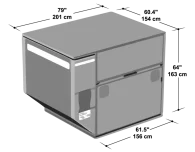 AAU Container
AAU Container
- Type: AAU CONTAINER
- ATA Code: LD29
- Internal Volume: 505 cu. ft. 14.3 mc
- Weight Limit: 4,626 kg
- Loadable Aircraft Type: 747, 747F
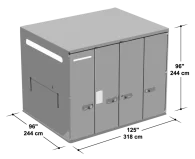 ALF Container
ALF Container
- Type: ALF CONTAINER
- ATA Code: LD6
- Internal Volume: 310 cu. ft. 8.78 mc
- Weight Limit: 3,175 kg
- Loadable Aircraft Type: 747, 747F,777, Airbus
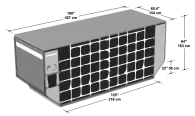 AMA Container
AMA Container
- Type: AMA CONTAINER
- ATA Code: M1
- Internal Volume: 621 cu. ft. 17.58 mc
- Weight Limit: 6,804 kg
- Loadable Aircraft Type: 747F
 AMF Container
AMF Container
- Type: AMF CONTAINER
- Internal Volume: 516 cu. ft. 14.6 mc
- Weight Limit: 5,035 kg
- Loadable Aircraft Type: 747,747F, 777, Airbus
P1P_PAG Pallet
- Type: P1P, PAG PALLET
- Size:
- Base: 88″x 125″
- Height: 64″, x 96″,118″
- Weight Limit: 4,626kg
(LD),6,033kg (MD) - Loadable Aircraft Type: 747,747F, 777, Airbus
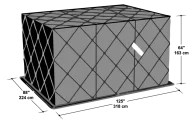 PEB Container
PEB Container
- Type: PEB CONTAINER
- Size:
- Base: 53″ x 88″
- Height: 84″
- Weight Limit: 1,800kg
(B-HIH -1,300 KG) - Loadable Aircraft Type: 747F
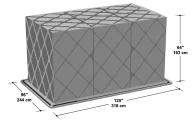 PLA Pallet
PLA Pallet
- Type: PLA PALLET
- Size:
- Base: 60.4″x 125″
- Height: 64″
- Weight Limit: 3,175kg
Loadable Aircraft Type: 747, 747F, 777, Airbus
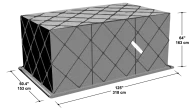 PMC_PQP_P6P Pallet
PMC_PQP_P6P Pallet
- Type: PMC, PQP, P6P PALLET
- Size: Base: 96″ x 125″
- Weight Limit: 5,035 kg (LD), 6,804 kg (MD)
- Loadable Aircraft Type: 747, 747F, 777, Airbus
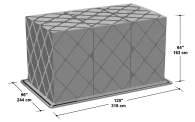 RKN Container
RKN Container
- Type: RKN CONTAINER
- ATA Code: LD3
- Internal Volume: 125.41 cu. ft. 3.55 mc
- Weight Limit: Weight: 1,588 kg
- Loadable Aircraft Type: 747, 747F, 777, Airbus
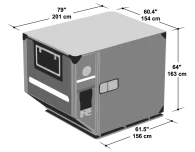 VZA_VRA
VZA_VRA
- Size: Fitted on PGA 20 ft. Pallet
- Max Width for Lower Car: 81″/ 205 cm
- Max Centre Height for Lower Car: 59″/ 150 cm
- Max Wheel Base: 312 cm
- Weight Limit: 2,500 kg(Upper Car)
9,300 kg c(Max Gross Weight of Pallet) - Loadable Aircraft Type: 747F Upper Deck
AIR FREIGHT FREIGHTER SPECIFICATIONS
| Make/Model | Max Payload Tonnes |
Max Loadable Volume CBM3 |
Cargo Hold Dims LxWxH cm |
Cargo Door Size WxH cm |
| Cessna 406 Titan | 1.2 | 6.5 | 320 x 120 x 117 | 124 x 116 |
| Fairchild Metroliner II | 1.4 | 12 | 835 x 115 x 120 | 130 x 115 |
| Fairchild Metroliner III | 2.1 | 12 | 775 x 158 x 145 | 130 x 115 |
| Fairchild Metroliner 23 | 2.3 | 18 | 775 x 158 x 145 | 127 x 115 |
| Falcon 20 / 200 | 2.5 | 11 | 704 x 156 x 142 | 190 x 140 |
| Shorts 360 | 3.5 | 40 | 815 x 190 x 190 | 142 x 168 |
| Saab 340 | 3.8 | 40 | 1300 x 170 x 170 | 135 x 130 |
| Aerospatiale ATR42 | 4.6 | 40 | 1080 x 225 x 143 | 125 x 153 |
| Fokker 27 | 6.3 | 58 | 1336 x 210 x 190 | 228 x 175 |
| Antonov AN-26 | 6.5 | 45 | 1110 x 220 x 160 | 230 x 171 |
| Antonov AN-74 | 6.5 | 45 | 1000 x 215 x 220 | 226 x 220 |
| British Aerospace ATP | 8.2 | 78 | 1500 x 195 x 180 | 250 x 169 |
| Lockheed L-188 Electra | 15 | 135 | 2000 x 280 x 220 | 355 x 203 |
| Boeing 737-300F | 16 | 115 | 2100 x 310 x 220 | 340 x 215 |
| Antonov AN-12 | 18 | 95 | 1380 x 300 x 250 | 300 x 250 |
| Lockheed L-100 Hercules | 21 | 140 | 1707 x 302 x 274 | 302 x 274 |
| Boeing 727-200F | 23.5 | 144 | 2712 x 351 x 218 | 340 x 218 |
| Boeing 757F | 39 | 187 | 3327 x 353 x 218 | 340 x 218 |
| Airbus A300 B4F | 40 | 280 | 3900 x 477 x 223 | 358 x 256 |
| Douglas DC8-62 | 40 | 200 | 3400 x 317 x 203 | 355 x 215 |
| Douglas DC8-54/55 | 41 | 180 | 3100 x 317 x 203 | 355 x 215 |
| Ilyushin IL-76 | 45 | 180 | 1850 x 345 x 325 | 344 x 340 |
| Antonov AN-22 | 50 | 650 | 2640 x 430 x 430 | 430 x 430 |
| Lockheed L10-11 Tristar | 55 | 420 | 3300 x 360 x 274 | 431 x 284 |
| Boeing 767-300F | 55 | 400 | 3000 x 400 x 250 | 340 x 254 |
| Douglas DC10-30 | 65 | 400 | 3725 x 448 x 245 | 350 x 245 |
| McDonnell Douglas MD11 | 85 | 500 | 4800 x 350 x 245 | 355 x 245 |
| Boeing 747-100F | 90 | 675 | 4800 x 488 x 300 | 340 x 300 |
| Boeing 747-200F | 100 | 675 | 4900 x 488 x 300 | 340 x 300 |
| Boeing 777F | 100 | 625 | 4400 x 488 x 300 | 372 x 305 |
| Boeing 747-300/400F | 110 | 675 | 5000 x 488 x 300 | 340 x 300 |
| Antonov AN-124 | 120 | 800 | 3650 x 640 x 440 | 640 x 440 |
| Antonov AN-225 | 250 | 1100 | 4300 x 640 x 440 | 640 x 440 |
INTERNATIONAL AIR FREIGHT AIRCRAFT
A wide variety of aircraft available for international air cargo.
AIRBUS A330-200
Utilised on domestic routes by Qantas
The A330-200, will uplift approx 14 ton or 61 cubic meters
(subject to weather conditions)
AIRBUS A330-300
Utilised by Qantas on domestic air freight routes
The A330-300, will uplift approx 15 ton or 80 cubic meters
(subject to weather conditions)
AIRBUS A320
Utilised by Qantas on domestic routes
The A320 will uplift 1 ton or approx 3 cubic meters
(subject to weather conditions)
AIRBUS A321
The A321 will uplift 3 ton or 10 cubic meters.
AIRBUS A330-800
The A330-800 will uplift 20 ton or 68 cubic meters.
BAE 146-300 FREIGHTER (Quiet trader)
The BAE 146 (Quiet trader as it is known)
Will uplift approx 10 ton or 80 cubic meters.
Boeing B737-300 Freighter
The 737 freighter will uplift approx 17 ton or 130 cubic meters.
Boeing B737-800
The 737-800 will uplift approx 3.5 ton or 30 cubic meters.
Boeing B767-300 Freighter
The 767 freighter will uplift 56 ton and 320 cubic meters.
Boeing B787-9
The 787-9 will uplift approx 18 ton or 96 cubic meters.
SHIPPING CONTAINER DIMENSIONS
20 ft Standard Dry (8'6" x 8' x 20')
Weight: 4500lbs
Max Gross Weight: 66,139lbs
Interior Dimensions:
Length: 19′ 5″
Width: 7′ 8-⅛”
Height: 7′ 9-⅝”
Door Opening:
Width: 7’ 8-½”, Height: 7’ 5-¾”
40 ft Standard Dry (8'6" x 8' x 40')
Weight: 8500lbs
Max Gross Weight: 66,139lbs
Interior Dimensions:
Length: 39′ ⅜”
Width: 7′ 8-⅛”
Height: 7′ 9-⅝”
Door Opening:
Width: 7’ 8-½”, Height: 7’ 5-¾”
40 ft High Cube (9'6" x 8' x 40')
Weight: 8750 lbs
Max Gross Weight: 68,008lb
Interior Dimensions:
Length: 39′ 4”
Width: 7′ 7”
Height: 8′ 9″
Door Opening: Width:
7’ 8″‘, Height: 8’ 5”
Dimensions of 20ft Flat Rack Container
Internal length 5.94 m / 19.5 ft
Internal width 2.35 m / 7.7 ft
Internal height 2.35 m / 7.7 ft
Tare weight 2,360 kg / 5,203.8 lbs
Payload capacity: 30,140 kg / 66,458.7 lbs
Cubic capacity 32.7 m³ / 1,154.3 cu ft
Dimensions of 40ft Flat Rack Container
Internal length 12.13 m / 39.8 ft
Internal width 2.40 m / 7.9 ft
Internal height 2.14 m / 7 ft
Tare weight 5,000 kg / 11,025 lbs
Payload capacity: 40,000 kg / 88,200 lbs
Cubic capacity 62.2 m³ / 2,195.7 cu ft
INTERNATIONAL CONTAINER SHIPPING PORTS
| Rank | Port | Website | ||||
| 1 | Shanghai, China | www.portshanghai.com.cn | ||||
| 2 | SIngapore | www.singaporepsa.com | ||||
| 3 | Shenzhen, China | www.szport.net | ||||
| 4 | Hong Kong, S.A.R., China | www.mardep.gov.hk | ||||
| 5 | Ningbo-Zhoushan, China | www.zhoushan.cn/english | ||||
| 6 | Busan, South Korea | www.busanpa.com | ||||
| 7 | Qingdao, China | www.qdport.com | ||||
| 8 | Guangzhou Harbor, China | www.gzport.com | ||||
| 9 | Jebel Ali, Dubai, United Arab Emirates | www.dpworld.ae | ||||
| 10 | Tianjin, China | www.ptacn.com | ||||
| 11 | Rotterdam, Netherlands | www.portofrotterdam.com | ||||
| 12 | Port Klang, Malaysia | www.pka.gov.my | ||||
| 13 | Kaohsiung, Taiwan, China | www.khb.gov.tw | ||||
| 14 | Dalian, China | www.dlport.cn | ||||
| 15 | Hamburg, Germany | www.hafen-hamburg.de | ||||
| 16 | Antwerp, Belguim | www.portofantwerp.com | ||||
| 17 | Xiamen, China | www.portxiamen.gov.cn | ||||
| 18 | Tanjung Pelepas, Malaysia | www.ptp.com.my | ||||
| 19 | Los Angeles, U.S.A. | www.portoflosangeles.org | ||||
| 20* | Keihin Ports, Japan | www.city.yokohama.lg.jp/en | ||||
| 21 | Long Beach, U.S.A. | www.polb.com | ||||
| 22 | Laem Chabang, Thailand | www.laemchabangport.com | ||||
| 23 | Tanjung Priok, Jakarta, Indonesia | www.priokport.co.id | ||||
| 24 | Ho Chi Minh, Vietnam | www.vpa.org.vn | ||||
| 25 | Bremen/Bremerhaven, Germany | www.bremen-ports.de | ||||
| 26 | New York-New Jersey, U.S.A. | www.panynj.gov | ||||
| 27 | Yingkou, China | www.ykport.com.cn | ||||
| 28** | Hanshin Ports, Japan | www.hanshinport.co.jp/en | ||||
| 29 | Lianyungun, China | www.lyg.gov.cn | ||||
| 30 | Columbo, Sri Lanka | www.slpa.lk | ||||
| 31 | Algerciras Bay, Spain | www.apba.es | ||||
| 32 | Jawaharlal Nehru, | www.jnport.gov.in | ||||
| 33 | Suzhou, China | suzhou.jiangsu.net/transportation/waterway/port | ||||
| 34 | Valencia, Spain | www.valenciaport.com | ||||
| 35 | Jeddah, Suadi Arabia | www.ports.gov.sa | ||||
| 36 | Sharjah, United Arab Emirates | www.sharjahports.ae | ||||
| 37 | Felixstowe, U.K. | www.portoffelixstowe.co.uk/ | ||||
| 38 | Santos, Brazil | www.portodesantos.com | ||||
| 39 | Manila, Philippines | www.ppa.com.ph | ||||
| 40 | Piraeus, Greece | www.pct.com.gr www.olp.gr/en | ||||
| 41 | Port Said East, Egypt | www.scctportsaid.com | ||||
| 42 | Balboa, Panama | www.ppc.com.pa/balboa.php | ||||
| 43 | Haiphong, Vietnam | www.vpa.org.vn | ||||
| 44*** | Seattle-Tacoma NW Seaport Alliance, U.S.A. | www.portseattle.org www.porttacoma.org | ||||
| 45 | Ambarli, Turkey | www.atlasliman.com | ||||
| 46 | Georgia Ports, U.S.A. | www.gaports.com | ||||
| 47 | Colon, Panama | www.amp.gob.pa | ||||
| 48 | Tanjung Perak, Surabaya, Indonesia | www.perakport.co.id | ||||
| 49 | Tanger Med, Morocco | www.tmpa.ima | ||||
| 50 | Salalah, Oman | www.salalah.com |
OVERSEAS SHIPPING LINES
ACL Atlantic Container Line: https://www.aclcargo.com/
Alianca Navegaceo e Logistica Ltda: https://www.alianca.com.br/home-en
ANL Container Line: https://www.anl.com.au/
APL American President Line: https://www.apl.com/
ARKAS Line: https://arkasline.com.tr/en/
Bahr: https://www.bahri.sa/
CCNI: https://www.ccni.cl/
CMA-CGM: https://www.cma-cgm.com/
CNC LINE Cheng Lie Navigation: https://www.cnc-line.com/
COSCO CONTAINER LINES: https://lines.coscoshipping.com/home
COSCO USA: https://na.coscoshipping.com/
COSCO Canada: https://world.lines.coscoshipping.com/canada/en/home
CP SHIPS: https://www.hapag-lloyd.com/en/home.html
CROWLEY: https://www.crowley.com/
CSAV: https://csav.com/
DAL – Deutsc https://www.dal.biz/
HEUNG A Shipping: http://www.heungaline.com/en/index.html
HUBLine: https://www.hubline.com/
HUGO STINNES: https://www.stinnes-linien.de/
HYUNDAI Merchant Marine (HMM): https://www.hmm21.com/company.do
Ignazio Messina Line: http://www.messinaline.it
INTERASIA Lines: https://www.interasia.cc/
Italia Marittima: http://www.italiamarittima.it/
Kambara Kisen: https://www.kambara-kisen.co.jp/en/
Kestrel Liner: https://www.kestrelliner.com/
KMTC Line: https://www.kmtc.co.kr/
LIBRA: https://www.libra.com/what-we-do/maritime/
MACS Shipping: https://www.macship.com/
Maersk Line: https://www.maersk.com/
MARFRET Compagnie Maritime: https://www.marfret.com/en/
Matson: https://www.matson.com/
MAXICON Container Line: https://www.maxiconline.com/
MOL Mitsui OSK Lines http://www.molpower.com
MSC: https://www.msc.com/
NSCSA National Shipping Company of Saudi Arabia: https://www.bahri.sa/
Nordana http://www.nordana.com/
NYK Nippon Yusen Kaisha Lines: https://www.nyk.com/english/
OOCL: https://www.oocl.com/eng/Pages/default.aspx
PDL Pacific Direct Line: https://www.npdlship.com/
PIL Pacific International Lines: https://www.pilship.com
Pollux & Castor container line: https://mrgc.com.pk/
RCL Regional Container Lines: https://www.rclgroup.com/
Royal Arctic Lines: https://www.royalarcticline.com/
SCI Shipping Corporation of India: https://www.shipindia.com/
Sea Star Line: https://www.seastariran.com/
Sinokor: http://www.sinokor.co.kr/kr/index.html
STX PanOcean: https://www.panocean.com/eng/Main
Swire Shipping: https://www.swireshipping.com/
Tarros: https://www.tarros.it/
TCC The Containership Company: https://tc-company.no/
T.S. Lines: https://www.tslines.com/hk
TRANSLINER: https://www.translinergroup.com/
Wan Hai Lines: https://www.wanhai.com/views/Main.xhtml
W.E.C. Lines: https://weclines.com/
Yang Ming: https://www.yangming.com/
Zim Line: https://www.zim.com/
SAVE TIME, SAVE MONEY
CargoMaster International Freight Forwarder Australia
At CargoMaster we strive to deliver cost effective freight forwarding services to business, government and private individuals.
Contact our team today CargoMaster Freight Forwarders Australia will save you too!
[email protected]
1300 767 136
Contact Us Now! … With CargoMaster Freight Forwarders Australia, we can Save you More!
Thank-you for contacting us, we appreciate the opportunity.
If your shipment relates to air freight or less than a container load of sea freight. Please include the weight and dimensions of each piece in your request.
We look forward to working with you, please feel free to call at any time.
TEL: 1300 767 136
|
|



